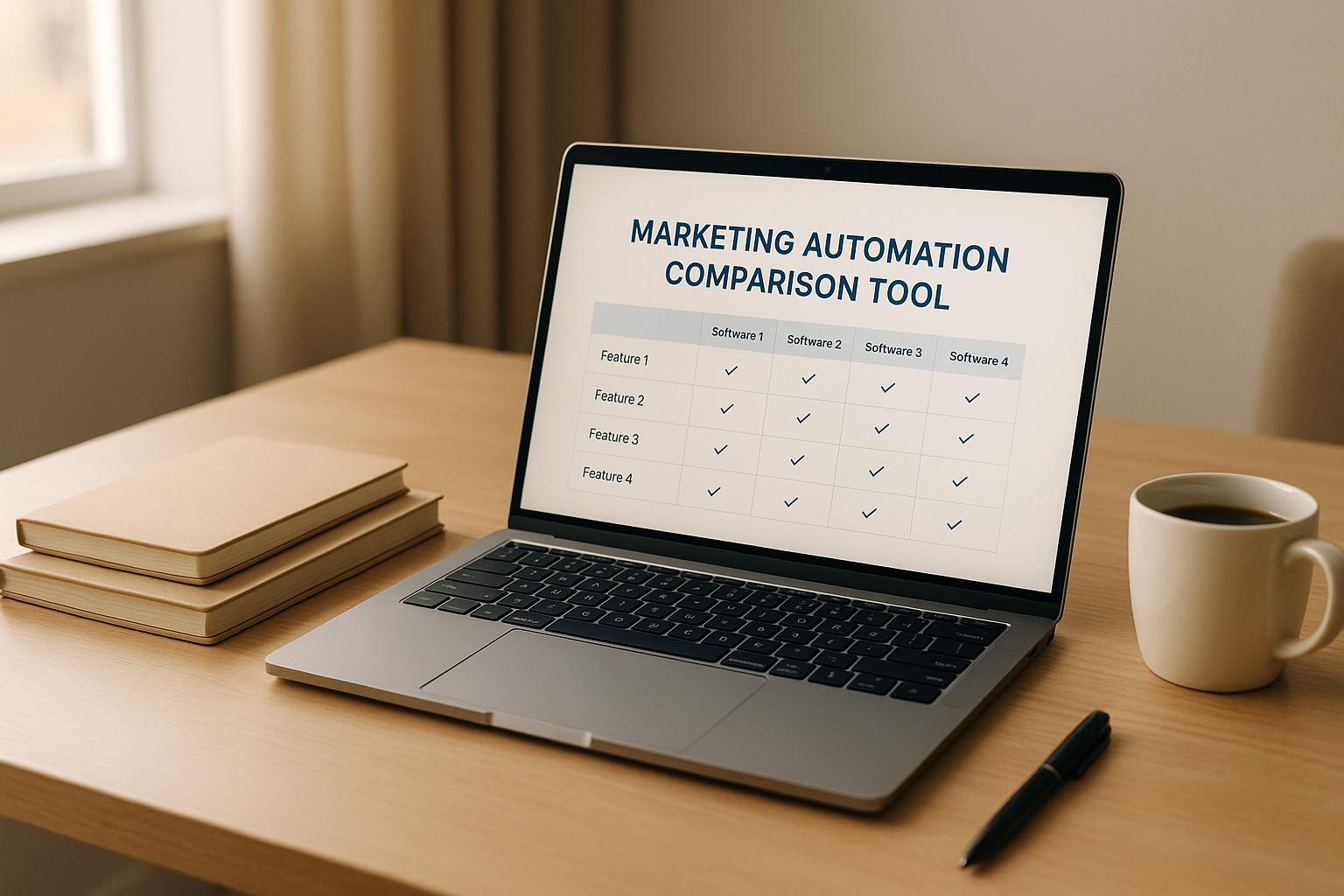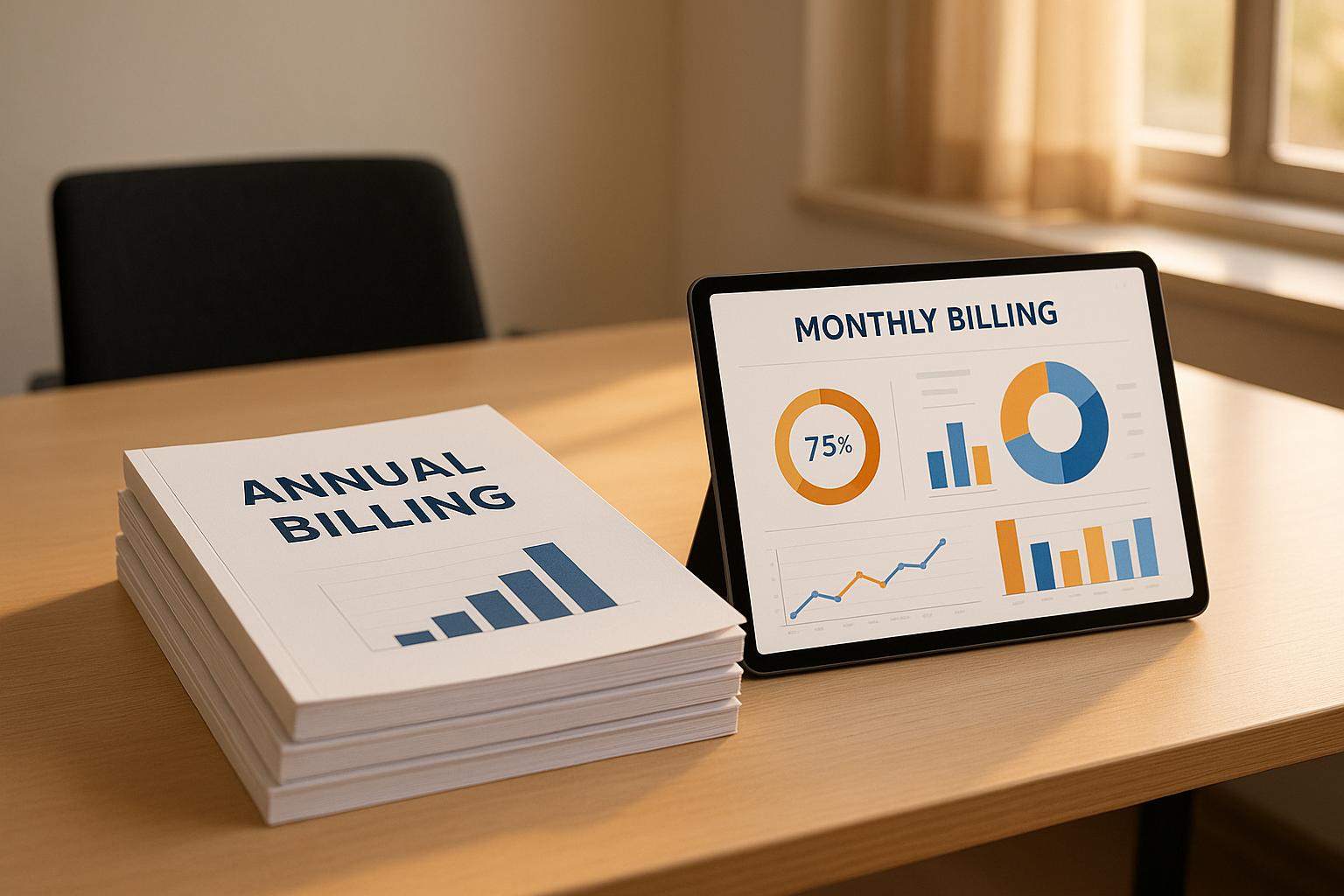For SaaS companies, growing revenue often means hiring more salespeople - a costly and time-consuming solution. AI sales tools offer a smarter alternative by automating repetitive tasks, qualifying leads, and improving sales processes. These tools allow teams to focus on closing deals while reducing operational overhead.
Here’s a quick look at 15 AI sales tools that can help you increase revenue:
- Outreach: Automates prospecting, email sequences, and lead engagement.
- Salesforce Sales Cloud (Einstein Copilot): AI-powered CRM with lead scoring, opportunity insights, and forecasting.
- Fireflies.ai: Transcribes and summarizes sales calls for better follow-ups.
- Gong: Analyzes sales conversations to identify winning strategies.
- Clari: Improves pipeline management and forecasting accuracy.
- Koncert: Handles multi-channel sales engagement and automated dialing.
- Apollo.io: Combines lead generation, engagement, and analytics in one platform.
- Drift: Uses AI chatbots to qualify leads and schedule meetings.
- Salesloft: Optimizes outreach with AI-driven cadences and deal tracking.
- HubSpot Sales Hub (AI Features): Automates prospecting, call summaries, and risk analysis.
- InsideSales (XANT): Predicts lead priorities and automates workflows.
- Zoho CRM (Zia AI): AI assistant for predictive sales and deal insights.
- People.ai: Automates CRM updates and provides relationship insights.
- Exceed.ai: AI chatbots for lead qualification and follow-ups.
Key Benefits of AI Sales Tools:
- Automate repetitive tasks (data entry, follow-ups, scheduling).
- Identify high-priority leads through AI-driven scoring.
- Personalize outreach at scale with tailored messaging.
- Improve forecasting accuracy using historical and real-time data.
- Integrate seamlessly with CRMs and other sales tools.
Quick Comparison Table
| Tool | Core Functionality | Pricing Range | Integration Examples |
|---|---|---|---|
| Outreach | Sales engagement automation | $100-$165/user/month | Salesforce, HubSpot, Dynamics |
| Salesforce Sales Cloud | AI-powered CRM | $25-$500/user/month | Salesforce ecosystem, AppExchange |
| Fireflies.ai | Meeting transcription | $10-$19/user/month | Zoom, Teams, Slack |
| Gong | Revenue intelligence | $12,000-$20,000/year | Salesforce, Outreach, HubSpot |
| Clari | Pipeline management | $50-$150/user/month | Salesforce, Dynamics, Slack |
| Koncert | Multi-channel engagement | $85-$125/user/month | Salesforce, HubSpot |
| Apollo.io | Sales intelligence | $49-$149/user/month | Salesforce, HubSpot, Zapier |
| Drift | Conversational marketing | $2,500/month+ | Salesforce, Slack, HubSpot |
| Salesloft | Sales engagement | $75-$125/user/month | Salesforce, LinkedIn, Dynamics |
| HubSpot Sales Hub | Inbound sales automation | $45-$1,200/user/month | HubSpot ecosystem, 3rd-party apps |
| InsideSales (XANT) | Predictive sales acceleration | $75-$150/user/month | Salesforce, Dynamics |
| Zoho CRM (Zia AI) | Predictive CRM insights | $14-$52/user/month | Zoho ecosystem, Microsoft 365 |
| People.ai | Activity automation | $30-$60/user/month | Salesforce, Outreach, Dynamics |
| Exceed.ai | Conversational AI for lead scoring | $1,950+/month | Salesforce, HubSpot, Pipedrive |
13 Best AI Sales Tools & Agents 2025 (Ranking & Full Demo)
How AI Changes SaaS Sales Efficiency
AI is reshaping how SaaS companies approach sales, transforming every stage of the process - from identifying potential customers to closing deals. By automating repetitive tasks and uncovering valuable insights, AI allows sales teams to focus on what they do best: building relationships and solving problems.
Smarter Lead Generation
AI dives deep into datasets like social media activity and web behavior to identify prospects with real buying intent. For instance, in 2025, a cloud-based CRM provider used an AI platform to scan LinkedIn updates and job postings, identifying companies expanding their sales teams. These hiring patterns often signal growth, making it the perfect time to introduce scalable CRM solutions. But it doesn’t stop at demographics - AI can pick up on signals like funding announcements, changes in tech stacks, or leadership transitions, ensuring your team targets leads that are ready to convert. This precision sets the stage for outreach that’s both timely and relevant.
Personalization at Scale
AI takes personalization to a whole new level by analyzing a prospect’s pain points and industry context. For example, a marketing automation SaaS leveraged AI to detect a prospect’s existing tools through tracking pixels and integrations. If the prospect’s website ran on a specific CMS, the system automatically highlighted features that integrated seamlessly with that platform. This tailored approach doesn’t just stop at emails or calls - it extends to product demos, where AI recommends which features to emphasize based on the prospect’s unique challenges. It’s personalization that feels one-on-one, even when scaled across hundreds of leads.
Better Sales Forecasting
AI’s ability to analyze past deals, current pipeline data, and market trends makes it a powerful tool for predicting sales outcomes. One global SaaS vendor used AI to uncover patterns, such as deals taking longer in regions with strict regulations. Armed with this insight, they adjusted timelines and allocated resources more effectively. These predictive capabilities help sales teams refine their strategies, ensuring resources are used wisely and revenue projections are more accurate.
Streamlined Engagement
AI doesn’t just predict outcomes - it actively engages with prospects. Tools like AI-powered chatbots can qualify leads, handle FAQs, and even schedule demos. For example, in 2025, a SaaS startup launched a chatbot equipped with natural language processing. It identified key terms in visitor questions, such as “pricing” or “enterprise security,” and responded with relevant information. The chatbot also gathered contact details and arranged personalized demos with human account executives. This seamless handoff keeps the sales process moving efficiently.
"Sharp, forward-looking take, Lionel! Especially on the distinction between augmentation and true agentic autonomy. One agent that's quietly redefining the category is Vivun's AI Sales Agent, Ava. While many agents support outreach or qualification, Ava proactively helps AEs from first call to close - automating the strategic sales work itself - building stakeholder maps, drafting RFPs, creating executive summaries - so reps can focus on connecting and closing. She's not just accelerating the motion; she's raising the bar on quality. Ava is also the only agent on the market that has been modeled after the world's best sellers; only relying on the LLM for the mouth (rather than the brain of the operations like most). Would love to see Ava considered in future AI selling conversations."
– Lindsay Morton, Director of Growth, More Power to Sales [1]
Spotting Upsell Opportunities and Managing Pipelines
AI also helps uncover upsell opportunities by analyzing customer behavior and support interactions. For example, if a customer’s inquiry hints at a need for additional features, AI flags it for the sales team to act. Additionally, AI monitors deal progression and alerts the team when engagement drops, offering suggestions to re-engage leads and keep the momentum alive.
1. Top SaaS & AI Tools Directory by Agile Growth Labs
The Top SaaS & AI Tools Directory is designed to connect SaaS businesses with AI-driven sales tools, helping them increase revenue without adding to their team size. It highlights tools that can boost monthly recurring revenue by leveraging automation. Here’s a closer look at what the directory offers:
Automation Capabilities
One standout tool featured is Salesforge.ai. This AI platform combines email automation with CRM functionality, enabling personalized outreach and simplifying sales workflows[1].
Integration with CRM and Sales Tools
The directory focuses on AI tools that integrate smoothly with widely used CRM and sales platforms. This ensures sales teams can access AI-powered insights directly within their current systems, making adoption seamless.
Strategic Guidance and Training
In addition to listing tools, the directory provides exclusive training and actionable strategies. These resources are tailored to help SaaS founders implement AI solutions effectively to maximize revenue growth.
2. Outreach
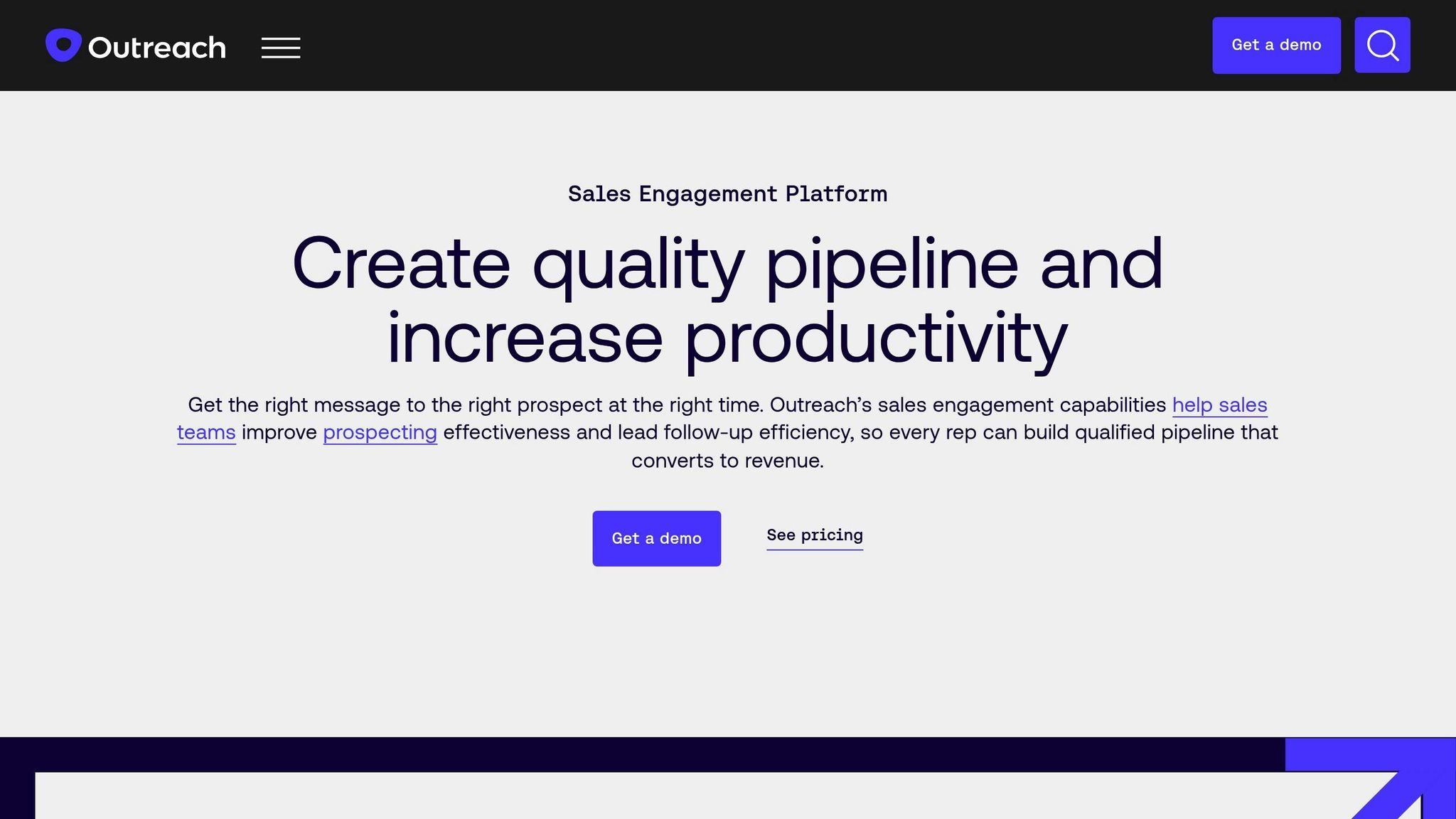
Outreach is an AI-driven sales engagement platform designed to help SaaS companies grow their revenue by automating and optimizing the sales process. By blending intelligent automation with seamless integrations, it simplifies everything from prospecting to closing deals. Let’s dive into how Outreach transforms sales workflows with its automation and data-driven tools.
Automation Capabilities
Outreach's AI Prospecting Agent changes the game for sales teams by taking over time-intensive prospecting tasks. This tool automatically researches prospects and accounts, crafts tailored content, and sends out autonomous email sequences. At just the right moment, it transitions leads to human sellers, ensuring a smooth handoff [4].
The Research Agent further simplifies the process by automating account research and identifying potential leads. This allows sales teams to focus on building relationships and closing deals rather than getting bogged down in preliminary tasks [4].
Lead Generation and Scoring
Outreach leverages predictive intelligence to analyze data - such as engagement signals, firmographics, and intent indicators - to segment prospects effectively. This approach ensures sales teams target the right people based on factors like industry, role, and previous interactions [4].
For example, Guild Mortgage saw significant results after adopting Outreach’s AI-powered lead generation tools. Their loan officers could quickly identify high-priority leads, reduce manual follow-ups, and deliver personalized outreach across multiple channels. This led to faster responses from leads and shorter deal cycles [4].
Integration with CRM and Sales Tools
Outreach integrates seamlessly with popular CRMs like Salesforce and Microsoft Dynamics 365 Sales [5]. It keeps lead data accurate and up to date with real-time version control, automatically tracking lead conversions [6]. These integrations not only simplify workflows but also enable precise revenue forecasting.
Revenue Optimization Features
By automating and fine-tuning the sales process, Outreach helps businesses increase revenue without needing to expand their teams. Its AI-powered forecasting tools enhance accuracy, enabling sales leaders to make informed decisions about revenue predictions and resource allocation [3]. Additionally, the platform supports hyper-personalized communication across various channels, ensuring that prospects receive timely, relevant messages that increase conversion rates.
Verkada’s experience highlights Outreach’s impact. Mallory Davis, Senior Sales Enablement Lead at Verkada, shared:
"We want them to work smarter, not harder, and Outreach really allows them to do that." [3]
3. Salesforce Sales Cloud (Einstein Copilot)
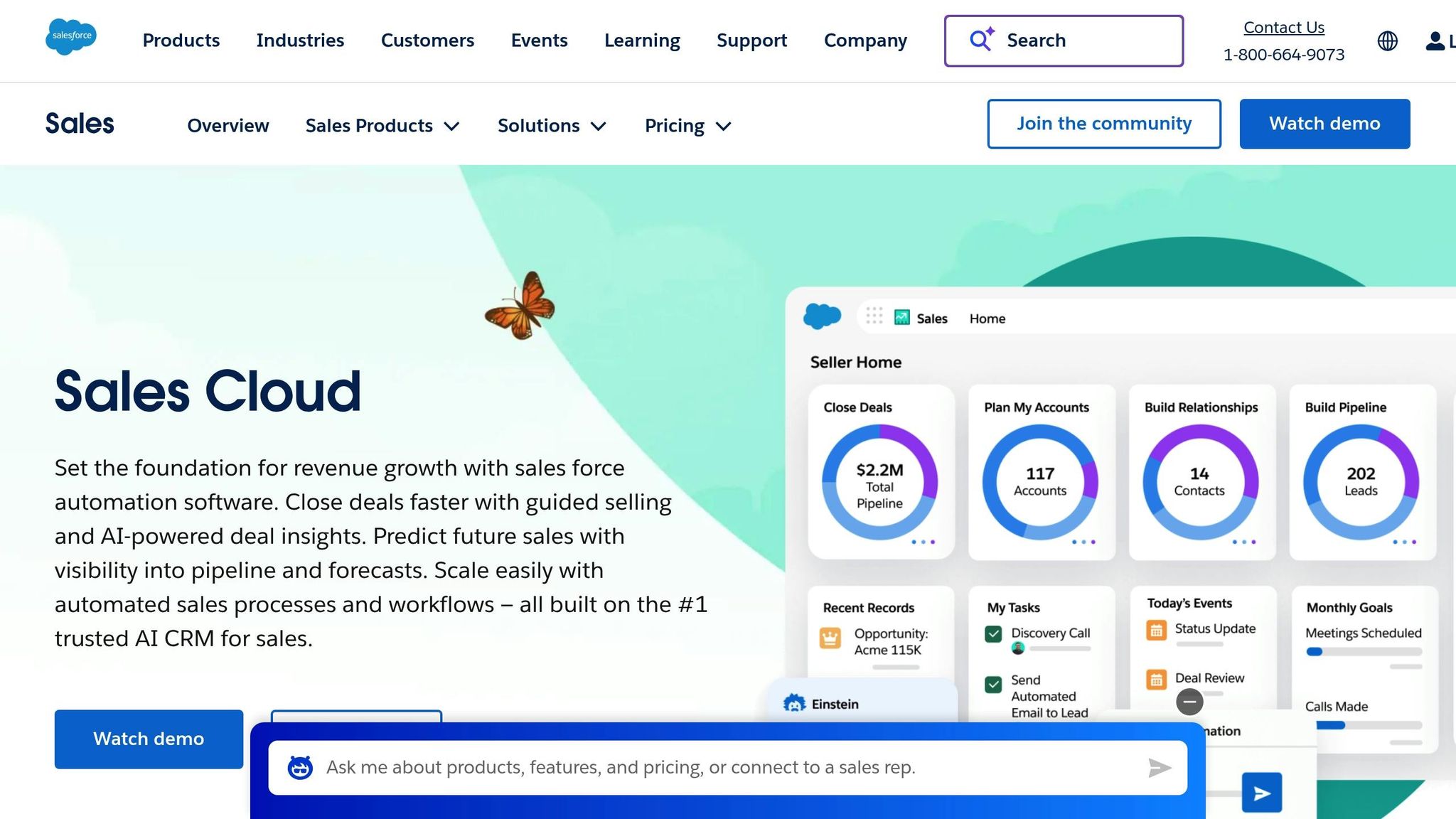
Salesforce Sales Cloud, enhanced with Einstein Copilot, brings AI-powered insights into one of the most widely used CRM platforms. By embedding intelligent automation and predictive tools throughout the sales process, it reshapes how SaaS sales teams operate. Einstein Copilot serves as a virtual assistant, helping sales reps make smarter decisions, automate repetitive tasks, and focus on activities that directly drive revenue. Let’s dive into its key features, including automation, lead scoring, integration, and revenue optimization.
Automation Capabilities
Einstein Copilot simplifies workflows with powerful automation tools. It takes over time-consuming tasks like updating records, scheduling follow-ups, generating summaries, and creating personalized templates. Using Einstein Activity Capture, it also logs interactions automatically, ensuring sales teams have complete visibility into their pipelines while saving hours of manual work.
One standout feature is Smart Response, which analyzes customer emails and suggests replies based on context and past successes. Sales reps can quickly review and send these AI-recommended responses, saving time and maintaining a personalized touch.
Lead Generation and Scoring
Einstein Lead Scoring leverages machine learning to evaluate historical data and pinpoint leads with the highest conversion potential. It considers factors like company size, industry, engagement trends, and demographic details to assign scores to prospects.
The platform also includes Einstein Opportunity Insights, which predicts which deals are most likely to close and when. By analyzing deal specifics, sales rep activities, and customer engagement, it offers accurate forecasts. This helps sales managers allocate resources effectively and guide their teams on the deals that require immediate attention.
Another useful tool, Einstein Account Insights, tracks external data sources like news and social media to detect buying signals. It sends alerts when prospects show heightened purchase intent, enabling sales teams to reach out at the right moment for maximum impact.
Integration with CRM and Sales Tools
Because Einstein Copilot is built directly into Salesforce Sales Cloud, it integrates seamlessly with existing workflows, custom fields, and processes already in place. No additional installations are needed.
It also connects with widely used communication tools like Slack, Microsoft Teams, and Gmail, making AI insights accessible within the tools sales reps already use. This eliminates the need to switch between multiple apps, keeping productivity high.
Additionally, Einstein Copilot syncs with marketing automation platforms, customer service tools, and business intelligence systems through Salesforce's AppExchange marketplace. This integration provides a unified view of customer interactions, empowering sales teams to make well-informed decisions.
Revenue Optimization Features
Einstein Forecasting uses historical sales data, pipeline health, and external variables to deliver precise revenue predictions. Sales leaders can analyze performance by territory, product, or individual reps to identify gaps and opportunities.
The Einstein Conversation Insights feature reviews sales call recordings to uncover effective talk tracks, objection-handling techniques, and closing strategies. Managers can use these insights to train their teams and replicate successful behaviors, leading to higher win rates and shorter sales cycles.
Next Best Action recommendations guide sales reps on what to prioritize daily, factoring in deal probability, customer engagement, and revenue potential. The AI suggests specific steps - like sending a follow-up email or scheduling a demo - to keep deals moving forward efficiently.
Lastly, Einstein Pipeline Inspection monitors deals for signs of stalling or loss. By analyzing engagement levels, communication patterns, and competitor activity, it flags at-risk opportunities early, giving sales reps a chance to act before it’s too late.
Together, these tools empower SaaS sales teams to increase revenue while keeping staffing costs steady, showcasing the practical power of AI in sales.
4. Fireflies.ai
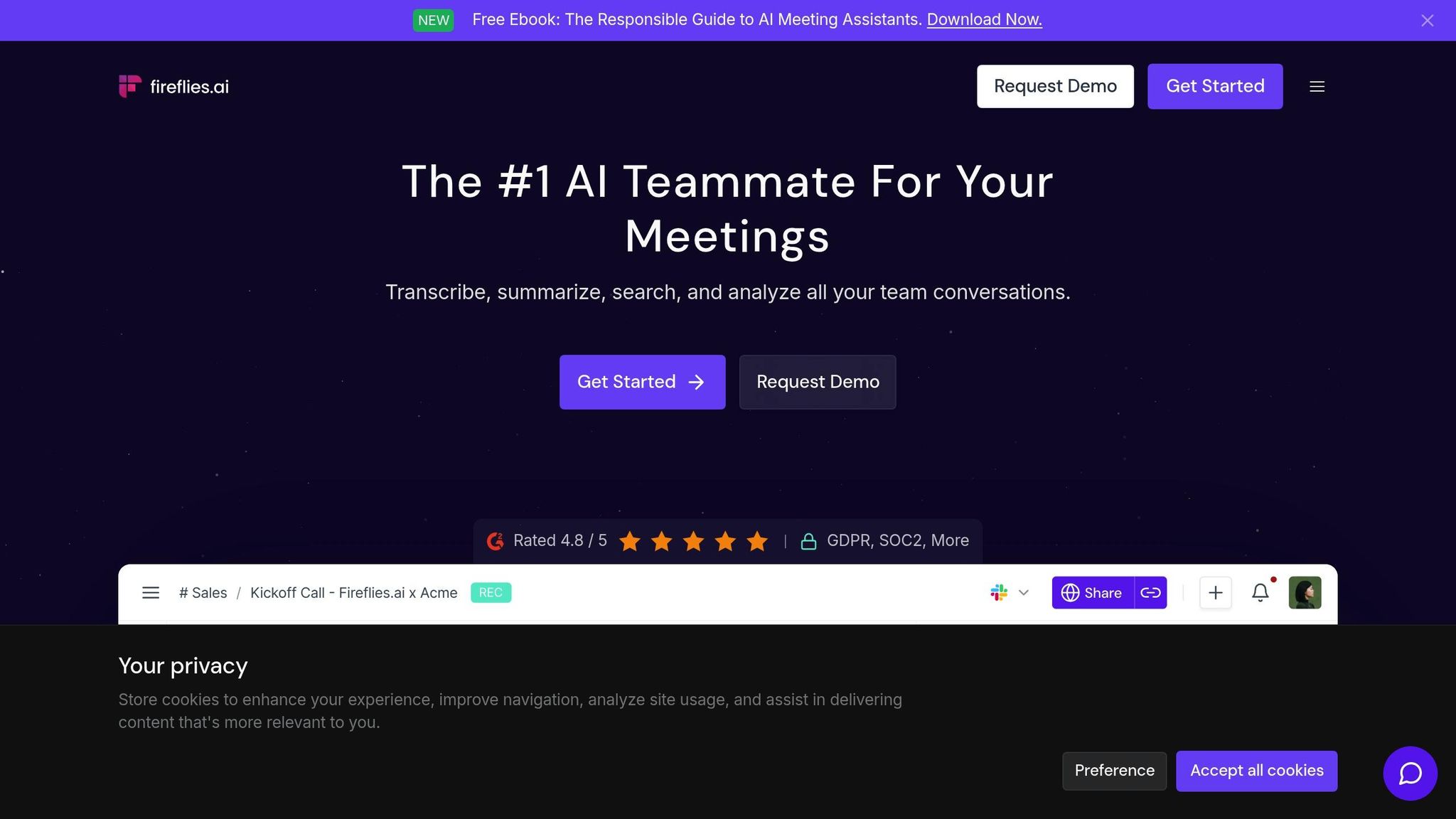
When it comes to streamlining the sales process, Fireflies.ai is a tool worth noting. It takes the hassle out of recording, transcribing, and summarizing sales calls, allowing teams to focus their energy on engaging with prospects instead of scribbling notes.
Automation Capabilities
Fireflies.ai creates searchable call records by transcribing and summarizing conversations. On top of that, its AskFred assistant can automatically draft follow-up emails, significantly reducing the workload after meetings. By simplifying call documentation and ensuring timely follow-ups, Fireflies.ai helps sales teams close deals faster while keeping every detail accounted for.
5. Gong
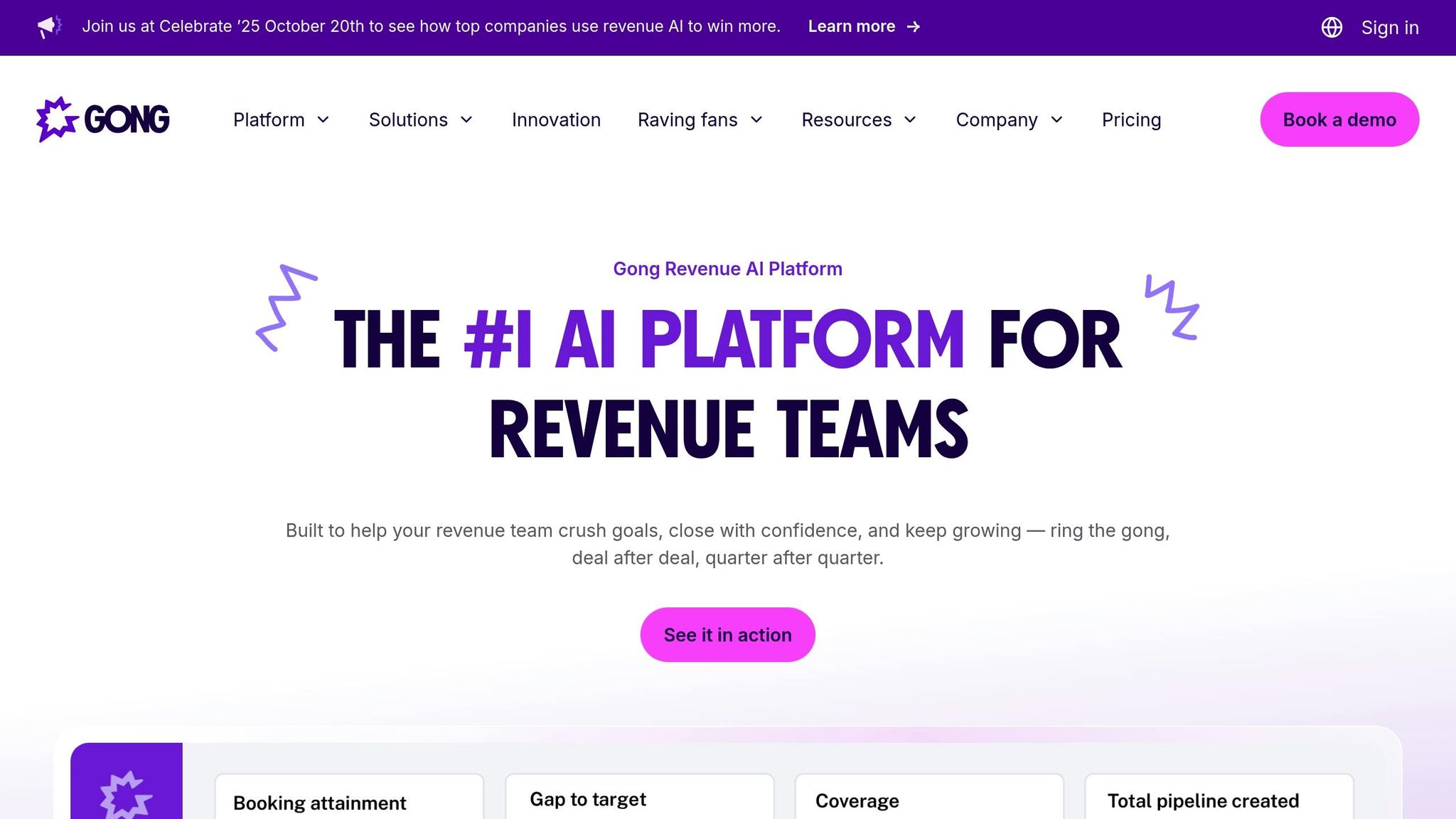
Gong is changing the game for SaaS sales teams by analyzing customer interactions and uncovering insights that lead to better outcomes. By diving deep into conversations across various channels, Gong helps sales teams adopt strategies that win deals.
Automation Capabilities
Gong takes the hassle out of manual note-taking by automatically recording and analyzing all customer-facing conversations. Whether it’s a call, email, or meeting, the platform transcribes interactions in real-time and uses natural language processing to spot critical moments - like mentions of competitors, buying signals, or key objections. This ensures that no important detail slips through the cracks.
What sets Gong apart is its coaching insights. The platform identifies successful patterns in speech, questions, and presentation styles that are common in closed deals. With this data, managers can coach their teams to replicate these winning behaviors, making every salesperson more effective.
Revenue Optimization Features
Gong’s revenue intelligence tools help SaaS companies avoid potential deal pitfalls before they escalate. By analyzing conversation trends, the platform flags deals that may be stalling or at risk. For example, if a prospect suddenly becomes less engaged or starts asking about competitors, Gong highlights these as warning signs, giving teams a chance to act before it’s too late.
The platform also tracks deal momentum, analyzing how often and how meaningfully prospects engage throughout the sales cycle. This helps teams focus their efforts on deals that are genuinely progressing, rather than wasting time on prospects who might not be serious. This targeted approach boosts close rates without requiring additional sales hires.
Another standout feature is Gong’s competitive intelligence. It automatically detects when competitors are mentioned during conversations and analyzes win/loss patterns against those rivals. Armed with this data, SaaS companies can refine their messaging and develop strategies to outmaneuver the competition.
Integration with CRM and Sales Tools
Gong works seamlessly with CRMs like Salesforce, HubSpot, and Pipedrive, syncing insights directly into deal records. This ensures everyone on the team has access to the same information without toggling between platforms.
It also integrates with video conferencing tools such as Zoom, Microsoft Teams, and Google Meet. For SaaS companies that rely on virtual sales, this feature ensures that every meeting is captured and analyzed, providing full visibility into customer interactions.
Gong’s workflow automation takes things a step further by triggering actions based on conversation insights. For instance, if a prospect mentions budget constraints during a call, Gong can automatically create a task for the account executive to follow up with pricing details or arrange a meeting with a decision-maker. These automated actions keep deals moving forward and make the entire sales process more efficient.
6. Clari
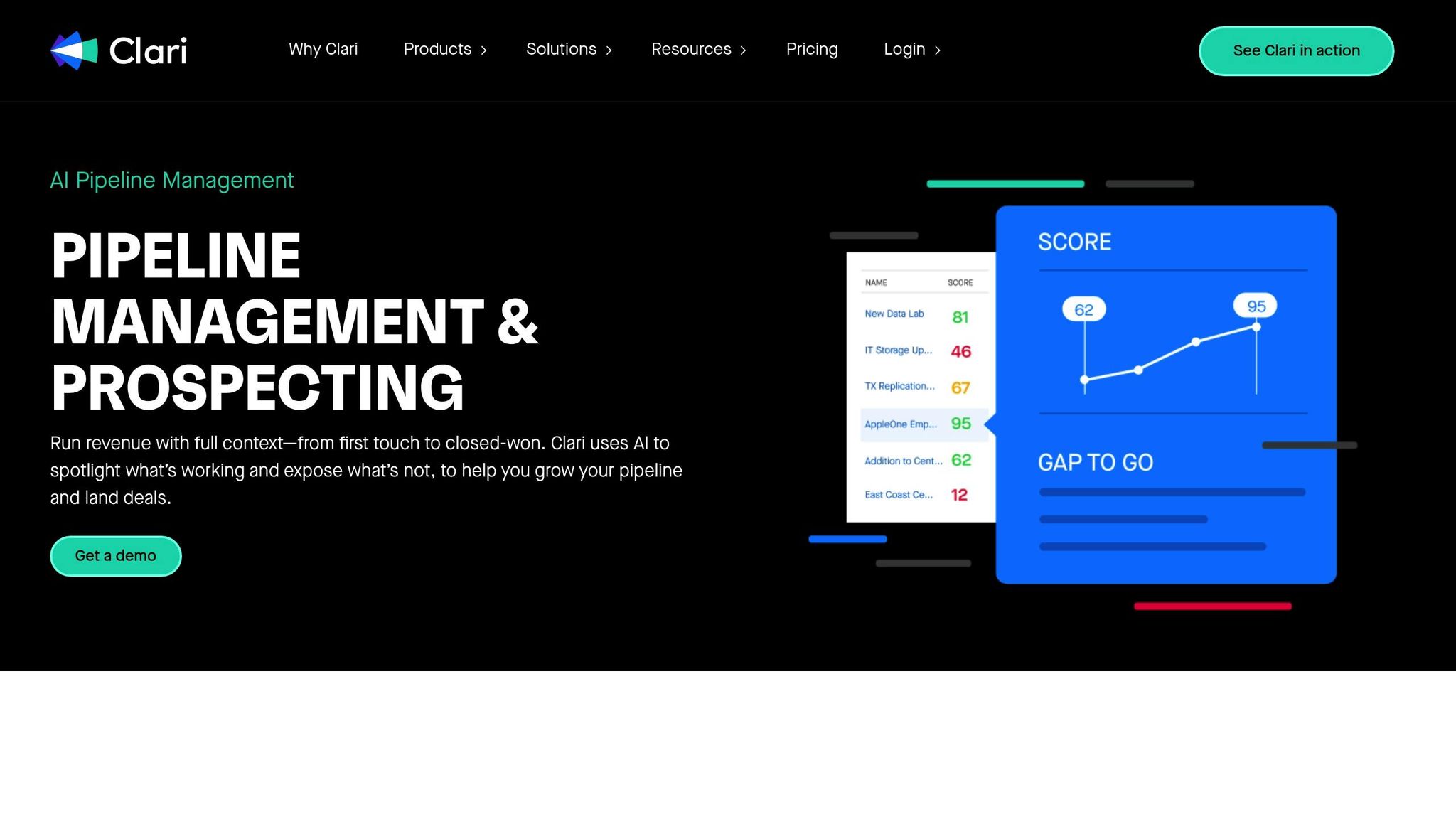
Clari stands out as a powerful tool for pipeline management and revenue forecasting. Designed with sales teams in mind, this AI-driven platform helps streamline processes, offering insights that enable smarter decision-making and a sharper focus on selling.
Automation Capabilities
Clari takes the hassle out of pipeline inspection and forecast preparation by automating key tasks. It monitors deal activity across emails, calls, meetings, and CRM updates, using this data to update deal health scores and probability assessments. This means outdated or incomplete deals are flagged automatically, while forecasts are aggregated across teams and updated in real time based on both deal activity and historical trends.
By handling these time-consuming tasks, Clari frees up sales teams to concentrate on what they do best - selling. Its consistent deal tracking and automatic updates create a solid foundation for improving revenue outcomes.
Revenue Optimization Features
Clari doesn’t stop at automation. Its revenue intelligence tools take things a step further by evaluating every opportunity in the sales pipeline. Through its deal inspection feature, it compares active deals with historical data, identifying which opportunities are most likely to close and which might need extra attention. This prioritization helps teams focus on high-probability deals, driving revenue growth without the need to expand the sales team.
Additionally, Clari tracks forecast performance over time, building trust in its predictions. These insights empower sales teams and leadership alike to make better decisions about where to allocate resources and how to plan strategically.
Integration with CRM and Sales Tools
Clari integrates seamlessly with popular CRM platforms like Salesforce, HubSpot, and Microsoft Dynamics. It also connects with email, calendar, and communication tools, offering a bi-directional sync that ensures actionable insights are woven into everyday workflows.
For businesses looking to go even further, Clari can link up with business intelligence tools, making it easy to incorporate its revenue predictions into broader dashboards and executive reports. This level of integration ensures that everyone, from individual team members to top executives, benefits from AI-driven insights. Plus, it provides a unified view of business performance that extends beyond sales metrics, offering a comprehensive look at overall operations.
7. Koncert
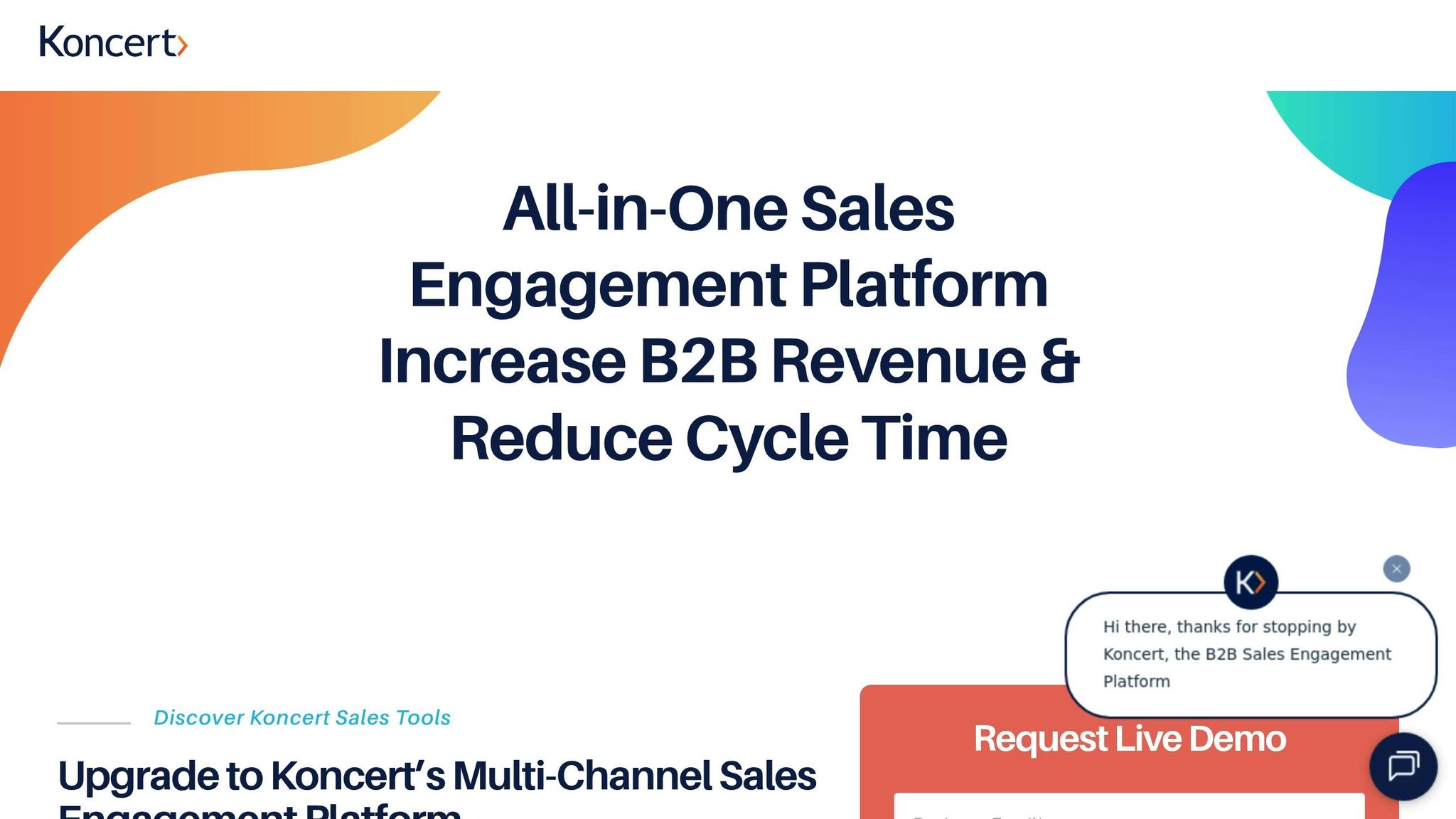
Koncert is all about simplifying outreach for SaaS companies through AI-powered dialing and multi-channel engagement. It helps teams handle outreach efficiently - without needing to grow their workforce.
Automation Capabilities
With Koncert's AI dialer, tasks like call logging, dispositions, and follow-ups are automated, allowing sales reps to focus on what matters most: meaningful conversations. The Koncert Cadence feature takes things a step further by coordinating outreach across multiple channels - calls, emails, video messages, and even social media. All of this happens effortlessly, without requiring constant manual input.
Integration with CRM and Sales Tools
Koncert integrates seamlessly with a wide range of tools. Its ecosystem includes over 100 apps, with automatic, two-way syncing for major CRMs like Salesforce, HubSpot, and Zoho. This ensures that every call result, disposition, and follow-up task is updated in real time.
"Koncert's multi-channel sales engagement platform provides real-time bi-directional syncing with many third-party systems, including CRMs, like Salesforce, and Email." [7]
The platform doesn't stop at CRMs. It also connects with popular sales tools like Salesloft, Outreach, Gong, and Apollo.io, as well as communication platforms like Slack. On top of that, Koncert automatically cleans up outdated contact data in CRMs, keeping your database accurate and campaigns effective. This level of integration makes it easier to manage multi-channel engagement while maintaining data quality.
Revenue Optimization Features
Koncert's real-time updates and detailed reporting give managers a clear view of team performance. By identifying what works and replicating those strategies across the team, businesses can fine-tune their sales processes and improve revenue outcomes. This data-driven approach ensures continuous improvement and better results.
8. Apollo.io
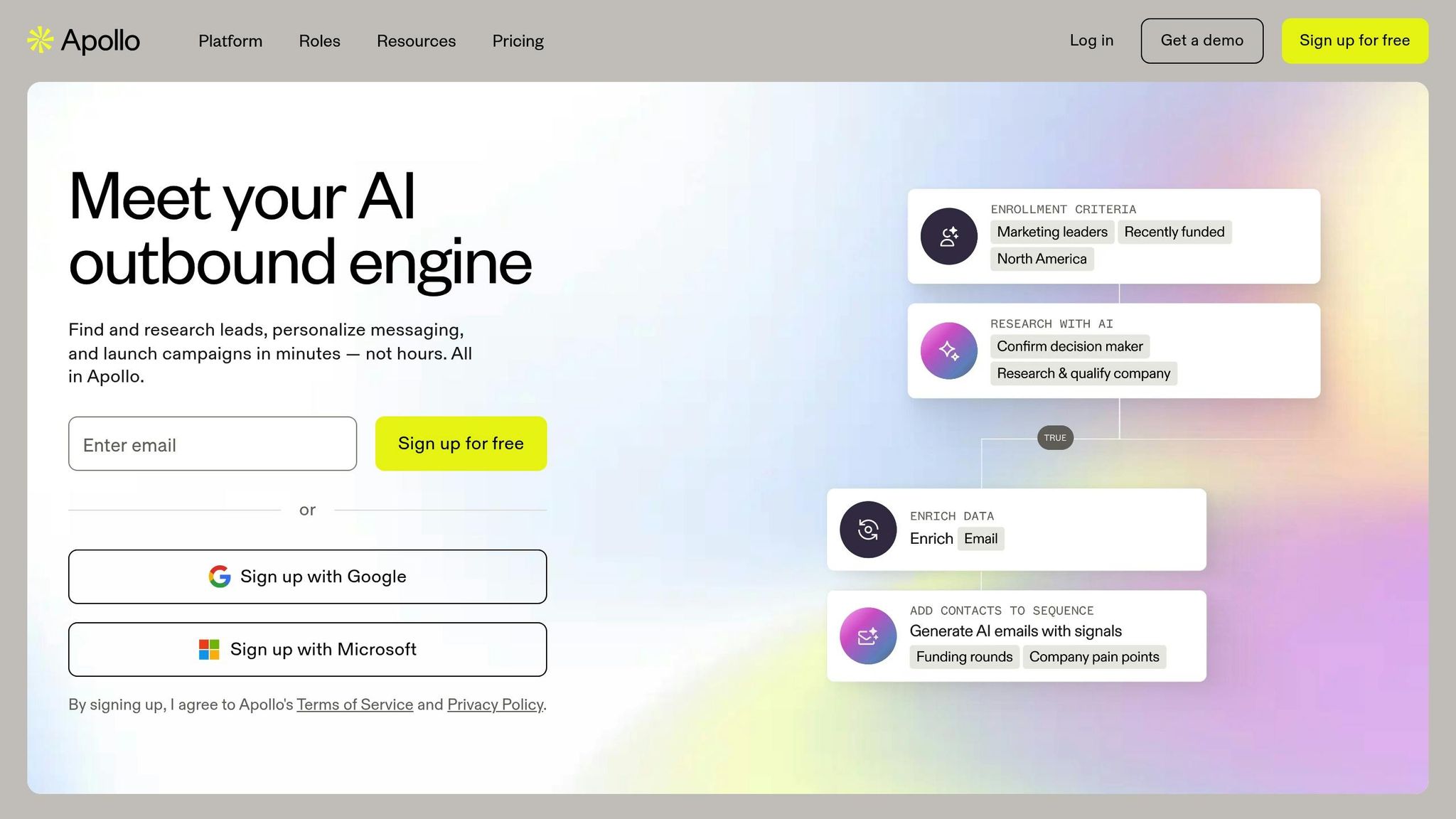
Apollo.io is a sales intelligence platform that combines prospecting, engagement, and analytics into one cohesive tool. It’s designed to help businesses increase revenue by leveraging data to streamline sales efforts.
Lead Generation and Scoring
Apollo.io uses AI to pinpoint high-potential prospects. It evaluates factors like company size, technology stack, funding activity, and job changes to identify the best leads. Its lead scoring system goes a step further, analyzing engagement signals - such as email opens and website visits - so sales teams can zero in on leads most likely to convert.
Automation Features
The platform’s Sequences feature automates multi-step email campaigns, adapting as needed and keeping contact data updated. Additionally, the Email Finder tool simplifies the process of locating prospect emails, saving time and effort on manual research.
Seamless CRM and Sales Tool Integration
Apollo.io integrates with popular CRMs like Salesforce, HubSpot, and Pipedrive, ensuring all prospect interactions and campaign activities are automatically synced. Its Chrome extension also provides quick access to contact data directly from LinkedIn, making prospecting even more efficient.
Tools for Revenue Growth
The Analytics Dashboard offers detailed insights into email performance, sequence outcomes, and team productivity. Sales managers can monitor key metrics like response rates and meeting bookings to fine-tune messaging strategies. The platform’s Conversation Intelligence feature adds another layer of insight by analyzing email exchanges to detect buying signals and determine the best follow-up times. These tools work together to increase conversion rates and shorten sales cycles. The next tool in this lineup also emphasizes data-driven sales engagement for optimal results.
sbb-itb-9cd970b
9. Drift
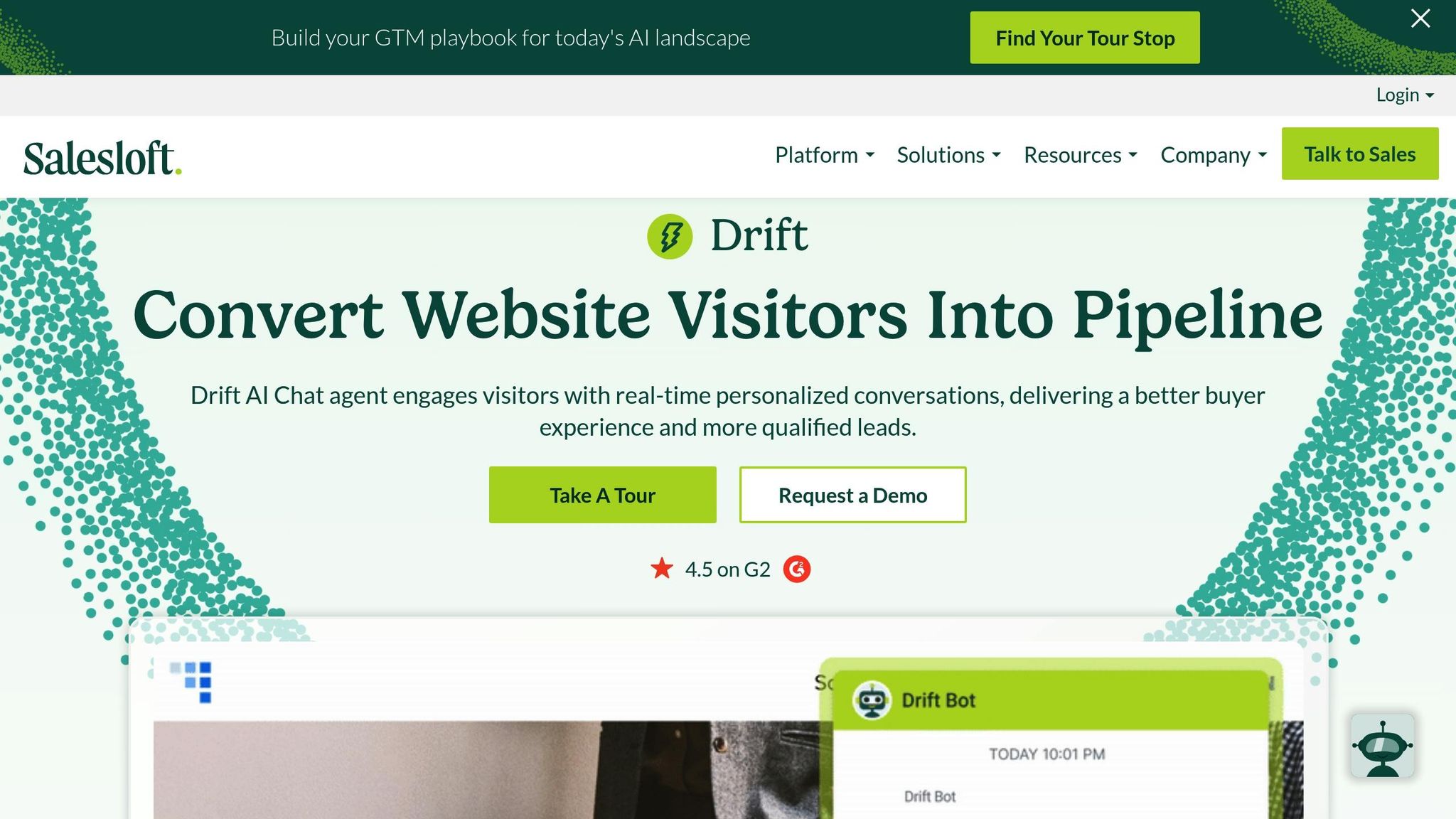
Drift is a conversational marketing and sales platform that uses AI-driven chatbots to engage website visitors. It’s designed to help SaaS companies streamline how they capture and qualify leads by creating tailored conversations that guide prospects through the sales funnel automatically.
Automation Capabilities
Drift’s Conversational AI takes care of those initial interactions with prospects. Its chatbots can qualify leads by asking specific questions about factors like company size, budget, and needs. For high-value prospects, the platform can automatically route them to the right sales representative or even schedule a meeting directly on the rep’s calendar.
The Playbooks feature allows businesses to create custom conversation flows based on visitor behavior, referral sources, or company size. For example, enterprise-level prospects might see different messaging and qualification questions than smaller businesses. This kind of automation sets the stage for more detailed lead evaluation.
Lead Generation and Scoring
Once leads are engaged, Drift integrates with popular CRM and scheduling tools to keep the process seamless. Its AI analyzes visitor behavior, tracking actions like page views, time spent on pricing pages, and return visits to identify buying intent signals. Based on these insights, the system assigns lead scores and sends instant notifications to sales teams when high-intent visitors are detected, ensuring no opportunity slips through the cracks.
Drift’s Account-Based Marketing (ABM) feature identifies visitors from target accounts and delivers tailored experiences. For instance, if someone from a priority company visits, the platform can display personalized messages and connect them directly with their assigned account executive.
Integration with CRM and Sales Tools
Drift connects effortlessly with major CRM platforms like Salesforce, HubSpot, and Marketo. All chat interactions, lead details, and conversation transcripts sync automatically, giving sales teams a complete view of each prospect’s journey. This ensures that follow-ups are informed and effective.
The platform also integrates with tools like Calendly, Zoom, and Google Calendar, making it easy for prospects to schedule meetings right through the chat. This eliminates the usual back-and-forth of coordinating demo or discovery call times.
Revenue Optimization Features
Drift’s Revenue Acceleration Platform provides detailed analytics on conversation performance and conversion rates. Its video messaging feature adds a personal touch that can drive conversions even further. Sales managers can monitor metrics such as chat-to-meeting conversion rates, response times, and which conversation flows bring in the most qualified leads.
10. Salesloft
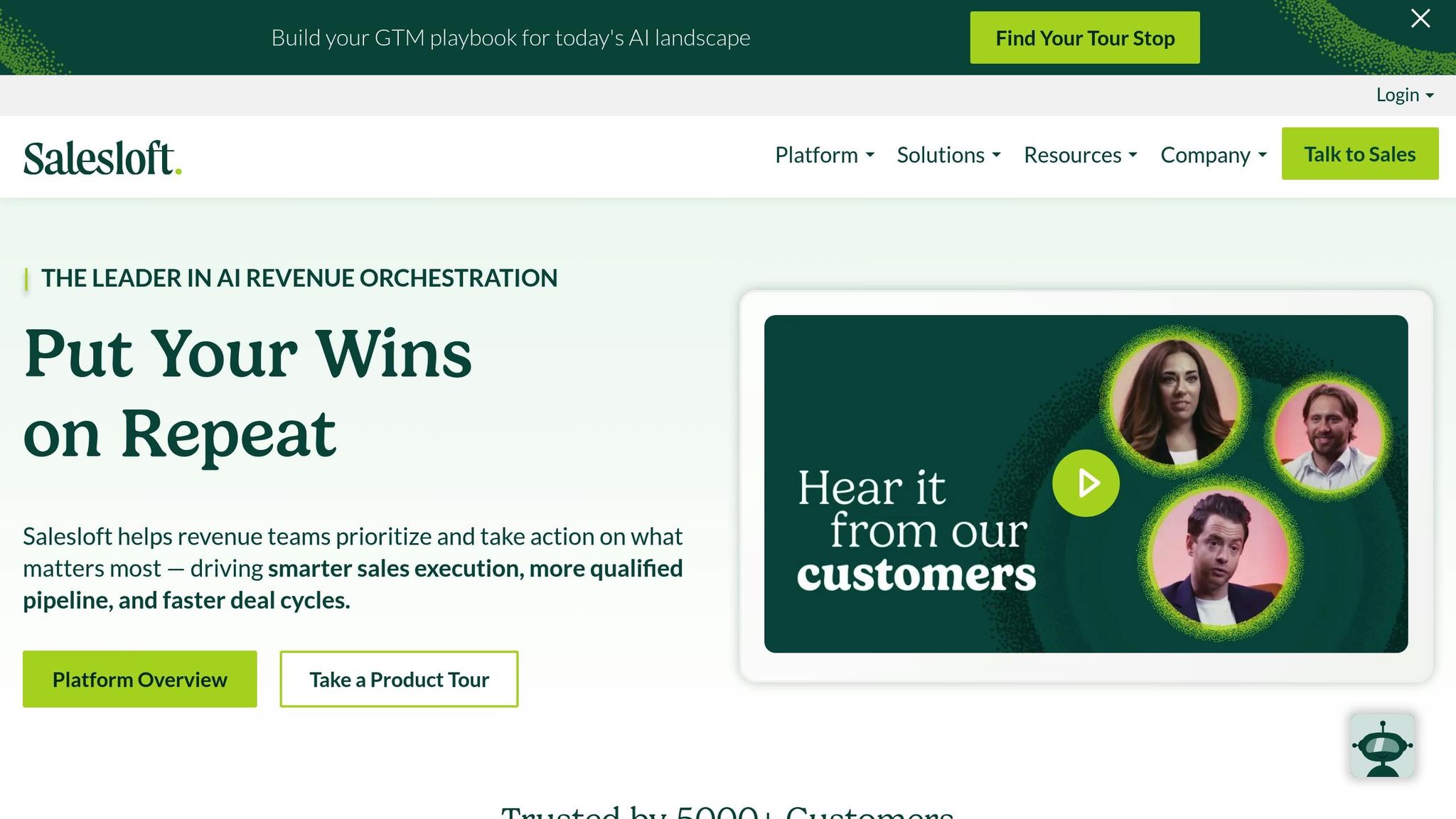
Salesloft stands out as a powerful AI-driven sales tool, designed to help businesses grow revenue without needing to expand their teams. It’s a sales engagement platform that uses AI to streamline outreach and deliver tailored communication.
Automation Capabilities
Salesloft’s Cadence feature takes the hassle out of multi-channel outreach. It automates sequences across email, phone, and social media, allowing sales teams to set up workflows that handle personalized emails, schedule follow-up calls, and even trigger LinkedIn connection requests - all based on how prospects engage. The AI optimizes timing for each interaction by analyzing factors like email open rates, response trends, and engagement history.
Another standout is the Rhythm functionality, which acts as a virtual sales assistant. It prioritizes daily tasks by surfacing the most critical prospects to contact and even suggests conversation topics based on recent news or social media activity. This feature eliminates the guesswork from daily planning, ensuring sales reps spend their time on activities that drive results.
Salesloft doesn’t just automate outreach - it also enhances lead qualification.
Lead Generation and Scoring
The Deals feature uses AI to monitor pipeline health and flag at-risk opportunities before they stall. By analyzing engagement signals, it assigns predictive scores to each deal. If engagement dips below a certain threshold, the system alerts managers and suggests specific actions to re-engage the prospect.
Meanwhile, the Buyer Signals feature tracks real-time prospect behavior, such as website visits, email interactions, and social media activity. For example, if a prospect repeatedly visits a pricing page or downloads a case study, the system notifies the sales rep immediately and recommends next steps. This ensures that high-priority leads get attention when they’re most interested.
Integration with CRM and Sales Tools
Salesloft integrates seamlessly with major CRMs like Salesforce, HubSpot, and Microsoft Dynamics, as well as tools like Zoom, Slack, and LinkedIn Sales Navigator. This integration creates a unified workflow, eliminating data silos and streamlining processes.
The Connect feature is particularly useful, allowing reps to make calls directly through the platform while automatically logging details into the CRM. It records and transcribes conversations, with AI analyzing the content to pinpoint key topics, objections, and next steps. This ensures no important details slip through the cracks, as all insights are fed back into the CRM.
Revenue Optimization Features
Salesloft’s Analytics dashboard provides a detailed view of sales performance, tracking metrics like email response rates, call connection rates, and conversion ratios from meetings to opportunities. This allows managers to replicate successful outreach strategies and address areas of underperformance quickly.
The Coaching feature takes sales training to the next level by analyzing conversations and offering targeted feedback. For instance, it can flag when a rep dominates a discovery call, misses qualifying questions, or overlooks buying signals. The system provides actionable insights and suggests training resources, helping reps refine their skills and improve conversion rates without adding extra management tasks.
11. HubSpot Sales Hub (AI Features)
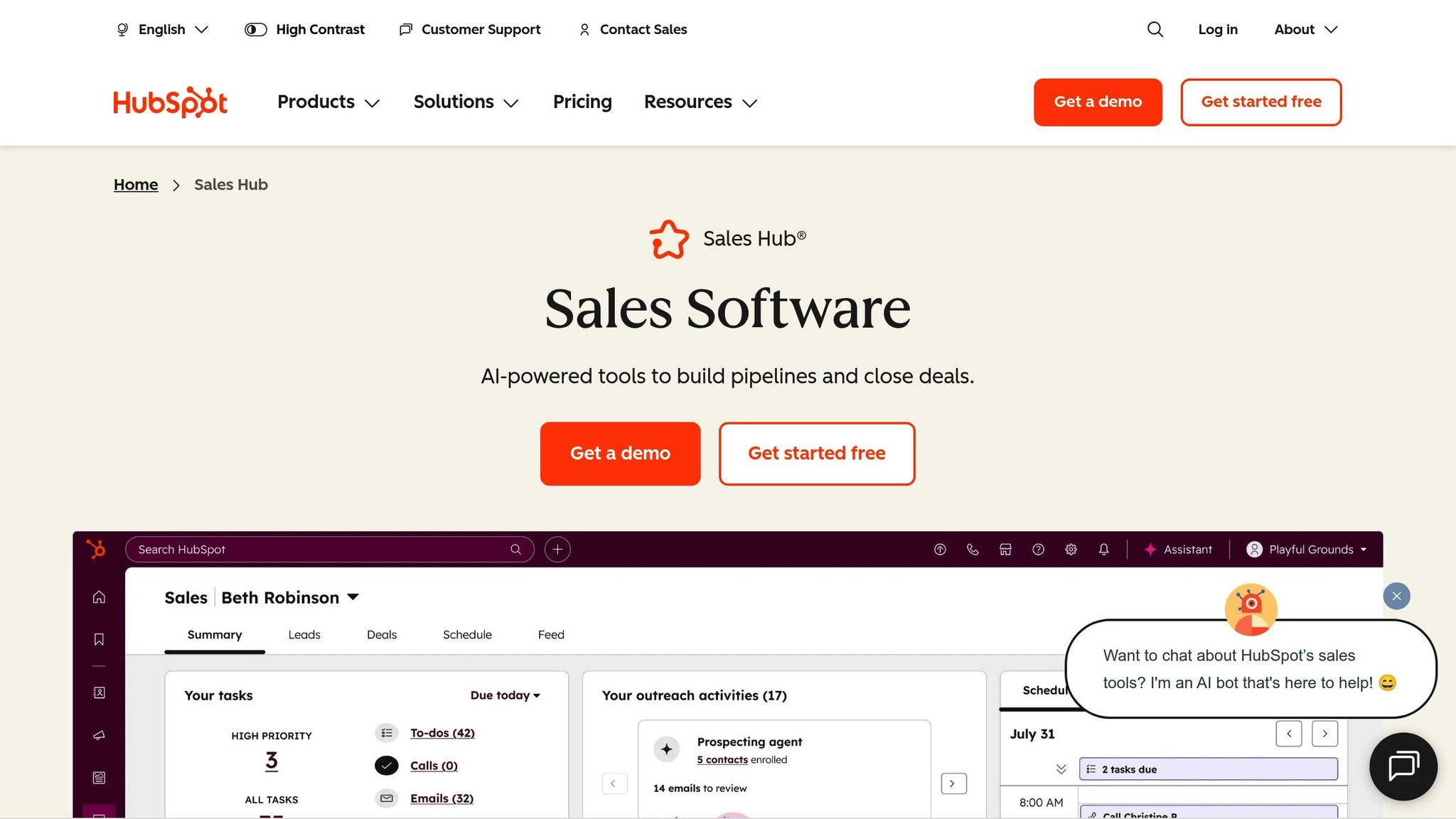
HubSpot Sales Hub has transformed into a sales platform powered by AI, designed to simplify workflows and increase revenue through smart automation. Its latest updates are all about moving teams from manual tasks to AI-driven processes, enabling them to identify opportunities earlier and optimize every step from prospecting to closing deals.
Automation Capabilities
The Prospecting Agent acts as a 24/7 AI assistant, scanning your database for buying signals and high-intent behaviors. Unlike traditional methods that rely on manual monitoring, this AI tool works nonstop to pinpoint the best opportunities.
"The new HubSpot Sales Hub AI features for B2B teams are the Prospecting Agent and Smarter Sales Meetings. The Prospecting Agent automates personalized outreach by detecting buying signals in real time, while Smarter Sales Meetings uses AI to transcribe, summarize, and identify risks from sales calls." - Keith Gutierrez [8]
Smarter Sales Meetings takes care of call transcriptions, summaries, and risk analysis, while tools like Breeze Copilot and Breeze Agents handle content creation, CRM updates, and pipeline management. These features automate tasks like personalized email drafting, identifying risks or objections, and generating concise summaries with follow-up actions.
Lead Generation and Scoring
HubSpot also leverages predictive analytics to improve lead prioritization. Its AI-powered lead scoring evaluates historical conversion data to rank prospects based on their likelihood to close. By analyzing behaviors such as engagement levels, content interaction, and demographic fit, the system dynamically adjusts scores as leads interact with your brand.
Integration with CRM and Sales Tools
HubSpot Sales Hub's AI capabilities are seamlessly embedded within the Sales Workspace, creating a unified platform. This integration eliminates the hassle of switching between multiple tools, as CRM records are automatically updated with insights from analyzed conversations.
Revenue Optimization Features
The platform's AI evaluates sales performance to determine which messaging, timing, and strategies yield the best results. It then fine-tunes outreach campaigns and suggests improvements for underperforming sequences.
Conversation analysis also plays a role in deal risk detection, flagging potential objections or concerns before they become major roadblocks. On top of that, the system offers tailored coaching recommendations by comparing individual sales reps' performance to successful patterns in the database. This helps teams sharpen their skills and boost conversion rates without requiring extra managerial oversight.
These AI tools are designed to help SaaS companies scale revenue efficiently while minimizing manual effort.
12. InsideSales (XANT)
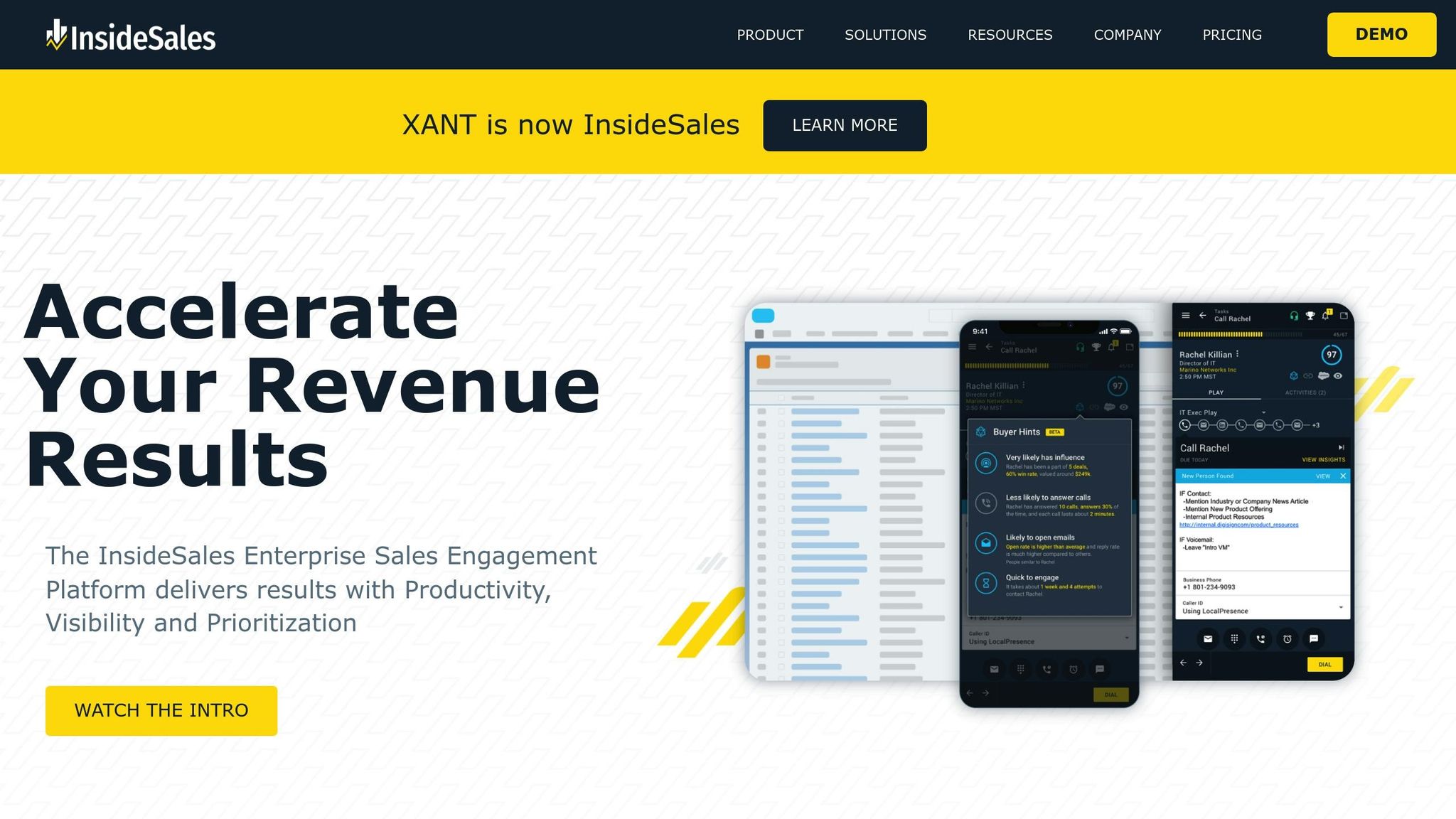
InsideSales, now operating as XANT, offers AI-driven tools for sales acceleration through its Playbooks™ platform. This system automates tasks and enhances CRM data with buyer intelligence, drawing insights from a massive dataset of 27 billion revenue interactions and 183 million buyer profiles[11]. It helps sales teams determine who to contact, when, and why.
Automation Capabilities
XANT’s Playbooks™ simplifies sales workflows with automated tools called "Robots." These tools handle repetitive tasks like syncing CRM fields, removing the need for manual updates.
The platform also streamlines opportunity engagement by standardizing how sales teams interact with prospects throughout the funnel. Plays are triggered based on opportunity status, helping advance deals and spotlighting key prospects.
"The amount of time I save through automation is fantastic. I couldn't imagine having to go back and log calls every time I make a dial, or even having to manually dial calls all day. InsideSales saves time so I can focus on the important aspects of my job." - G2 Review [9]
With automated enrollment, leads, contacts, and opportunities are seamlessly added to Plays. When a Play delivers results, Robots can auto-enroll similar opportunities into the same sequence, ensuring consistent outcomes.
The Auto-Send feature allows users to schedule emails or use "SmartSend", which employs analytics to find the best time to send messages. Pre-recorded voicemail messages can also be scheduled with a single click, saving even more time.
"The feature that helps me to be successful in my role is the auto-send email feature. This allows potential customers to respond to me about their interest in our products or services before a call." - G2 Review [9]
Beyond automation, XANT leverages AI to refine lead prioritization, ensuring sales reps dedicate their time to the most promising opportunities.
Lead Generation and Scoring
XANT’s AI dives deep into historical data and buyer behavior to predict which leads are most likely to convert. Using tiered rules, it automatically prioritizes leads, so reps can focus on those with the highest potential.
The system also manages shared and personal records efficiently. Shared Records create a pool of unassigned leads that any rep can access, while "Urgent Task" alerts ensure no lead is left unattended by distributing tasks in a round-robin style.
Alerts and activity triggers keep follow-ups consistent by monitoring events and activating tasks when needed. For example, time-based alerts can notify reps to re-engage opportunities that have been dormant for a set period.
Integration with CRM and Sales Tools
XANT integrates seamlessly with top CRMs like Salesforce and Microsoft Dynamics 365, offering reliable performance and secure data encryption during transit and storage[10].
Rather than replacing CRM data, XANT enhances it, building on existing investments. All activities within Playbooks are logged in real time, ensuring accurate and up-to-date CRM records.
A dedicated integration team focuses on optimizing CRM connectivity, ensuring fast and efficient performance. Additionally, a sidebar feature lets users easily access CRM data for calls and emails, simplifying day-to-day tasks.
Revenue Optimization Features
XANT’s tools go beyond automation and lead scoring to directly impact revenue growth. By enriching CRM data with actionable buyer intelligence, sales teams gain insights into prospect behavior and preferences. This helps prioritize activities, ensuring reps spend their time where it matters most.
The platform’s AI also determines the best times for outreach by analyzing historical data from 27 billion revenue interactions. This predictive approach identifies when prospects are most likely to engage and respond positively[12].
To make things even smoother, XANT ensures a reliable bi-directional sync between its platform and CRM systems. This means all prospect interactions and engagement data flow seamlessly, giving sales teams a complete view of their pipeline without adding extra manual work.
13. Zoho CRM (Zia AI)
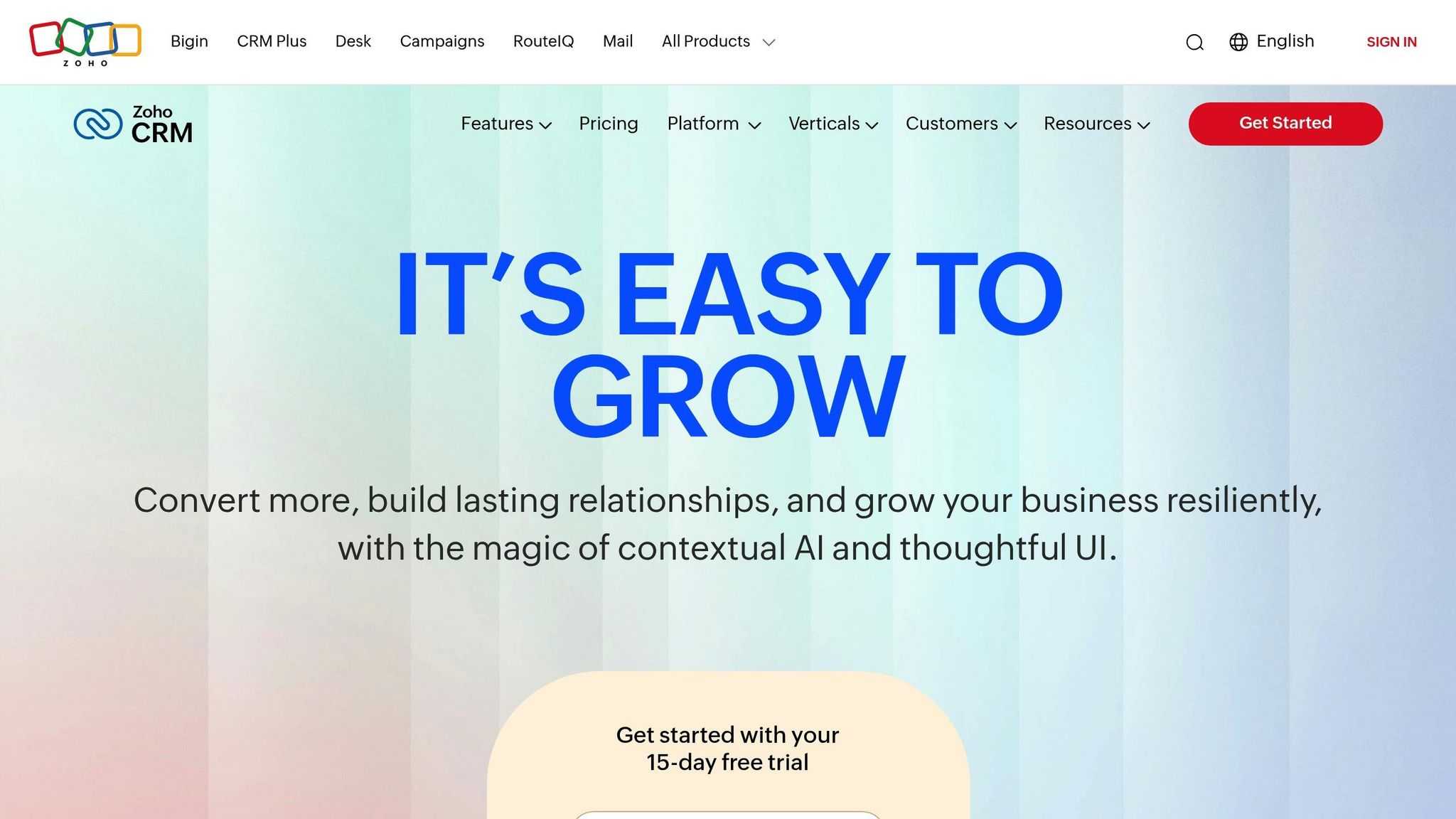
Zoho CRM's built-in AI assistant, Zia, reshapes SaaS sales by weaving intelligent automation and predictive insights into everyday workflows. It streamlines operations, reducing the need for constant app-switching, and gets smarter over time by learning from your sales data. This allows it to spot trends and uncover opportunities that might otherwise go unnoticed.
Automation Capabilities
Zia takes care of repetitive tasks that can bog down sales teams. For instance, it automatically logs emails to ensure no customer interaction slips through the cracks. It categorizes responses, updates deal stages, and assigns tasks based on how deals progress or prospects behave. Smart notifications keep sales reps informed when deals show signs of slowing down, and voice-to-text functionality makes it easy to turn spoken notes into organized CRM entries.
Lead Generation and Scoring
With predictive lead scoring, Zia ranks prospects by analyzing factors like email activity, website interactions, and company details. It can even spot unusual changes in behavior - like a sudden spike in engagement - that might signal a hot lead. On top of that, Zia uses location-based data and seasonal patterns to help sales teams manage territories more effectively and distribute leads strategically.
Integration with CRM and Sales Tools
Zia’s predictive powers are seamlessly integrated into Zoho CRM, enabling it to analyze customer interactions, forecast sales, and automate tasks without requiring complicated setups. It works hand-in-hand with other Zoho tools, such as Zoho Campaigns for marketing, Zoho Desk for customer support, and Zoho Analytics for detailed reporting. Plus, Zia connects with third-party platforms like Google Workspace and Microsoft Office 365, enriching customer profiles. With mobile accessibility, sales teams can tap into Zia’s features anytime, anywhere.
Revenue Optimization Features
Zia enhances sales forecasting by examining historical data, the current pipeline, and market trends to deliver precise revenue predictions. It also improves deal analysis by monitoring communication frequency, response times, and engagement levels, helping sales reps focus on deals that need immediate attention. Additionally, Zia’s performance analytics provide valuable insights into both individual and team productivity, enabling managers to zero in on activities that drive results.
14. People.ai
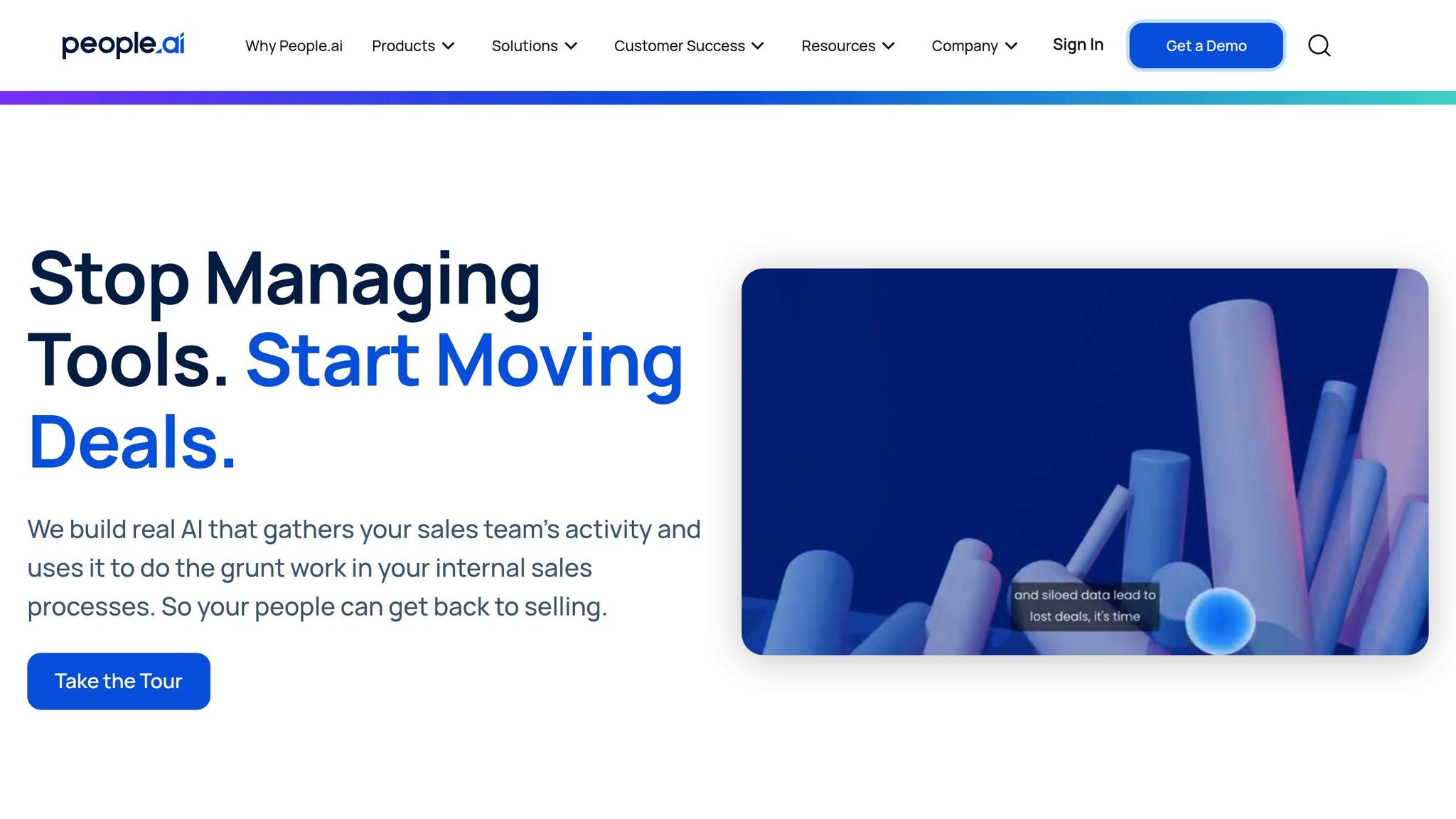
People.ai is changing the game for SaaS sales by automating the way activities are captured and synced with your CRM. By pulling data from emails, calls, meetings, and other touchpoints, it delivers insights that fit seamlessly into your existing workflow. This automation isn't just a time-saver - it brings clarity and precision to your sales process.
Automation Capabilities
Say goodbye to the hassle of manual data entry. People.ai takes care of it by automatically capturing go-to-market activities and updating your CRM in real time. With this system, your sales team can spend more time selling and less time on administrative tasks. It tracks activities for every account and opportunity, logs time spent by team members, and updates contact roles as interactions happen. The result? Complete and up-to-date sales data without lifting a finger.
Integration with CRM and Sales Tools
Beyond automation, People.ai connects the dots across various platforms, creating a unified sales ecosystem. It integrates with a range of tools, including CRM systems, sales engagement platforms, conversation intelligence software, and marketing automation solutions. This integration simplifies workflows and helps teams make smarter decisions.
For example, it automates activity and contact creation in Salesforce, embeds AI-driven insights into Microsoft 365, and works with tools like ClosePlan in Outreach and ZoomInfo to capture customer emails and identify key stakeholders.
Revenue Optimization Features
People.ai takes revenue optimization to the next level by giving you a clearer view of your sales pipeline and customer relationships. The platform builds detailed relationship maps to help sales teams understand the network of decision-makers in complex enterprise deals. By capturing every customer interaction, it equips sales managers with the insights they need to make data-driven decisions about team performance and resource allocation. This all-in-one approach to data and CRM integration allows SaaS companies to refine their sales strategies without adding more staff.
15. Exceed.ai
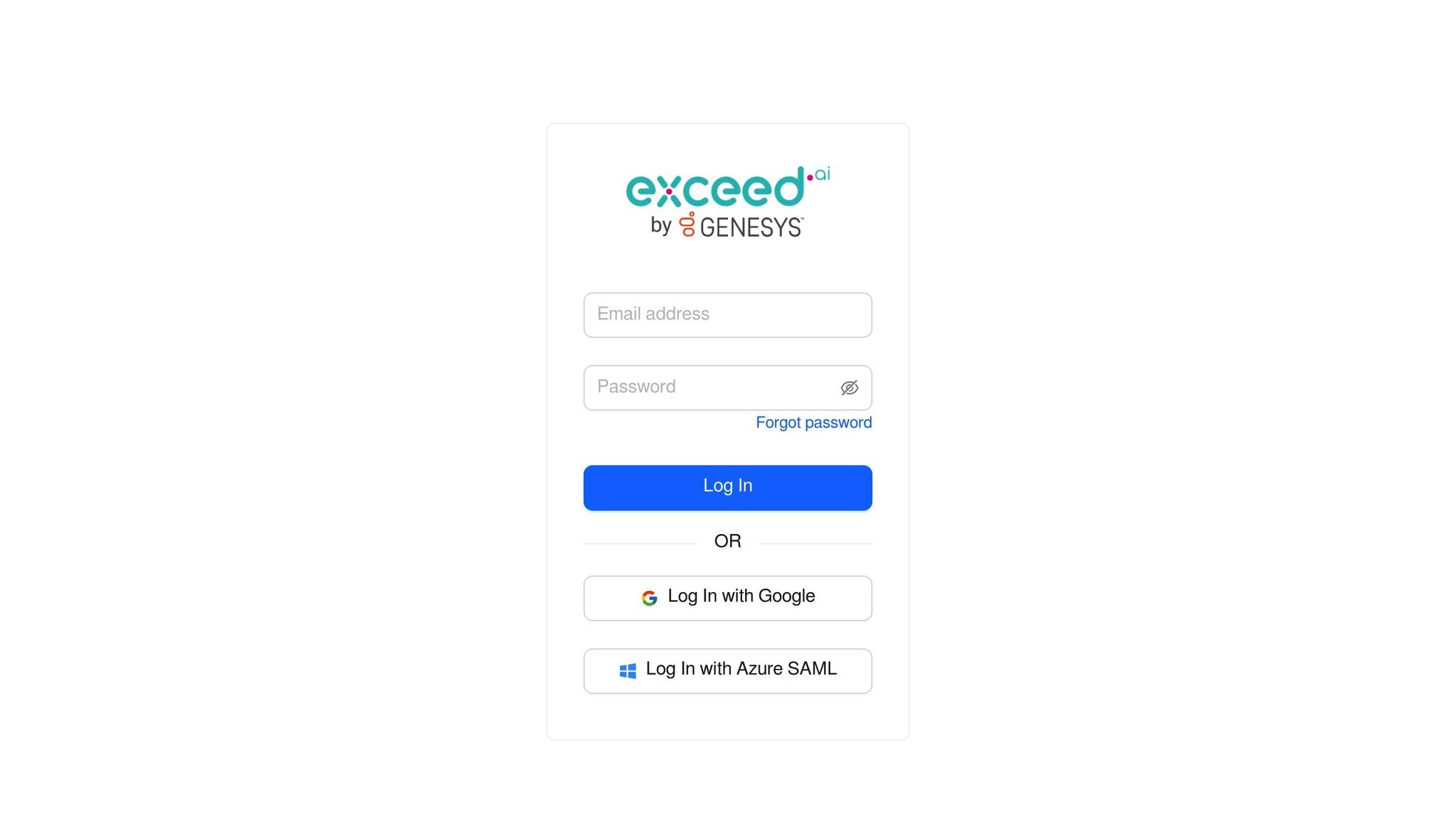
Exceed.ai wraps up our list as a conversational AI platform that streamlines lead qualification through personalized chatbot interactions. It engages prospects early in the sales process, freeing up your team to focus on closing deals. Starting at $1,950 per month, it’s tailored for SaaS companies looking to scale their lead qualification efforts without expanding their workforce. Here’s a closer look at its standout features.
Automation Capabilities
Exceed.ai’s AI chatbots operate 24/7, holding natural-sounding conversations with prospects. These bots handle targeted qualification discussions, identifying genuine interest and even scheduling meetings when appropriate. Prospects can interact across multiple channels, including email, website chat, and SMS.
The platform also automates follow-up sequences, keeping leads engaged over time. Whether a lead is ready to move forward or opts out, Exceed.ai ensures no opportunity is overlooked.
Lead Generation and Scoring
Exceed.ai evaluates prospects by analyzing their responses, engagement patterns, and needs. This scoring process helps prioritize high-value opportunities, allowing your sales team to focus their energy where it matters most.
The platform simplifies qualification by asking targeted questions about budgets, timelines, decision-making roles, and pain points. Based on their answers, leads are categorized, ensuring only the most promising prospects make it to your sales team’s calendar.
Integration with CRM and Sales Tools
Exceed.ai integrates seamlessly with major CRM platforms like Salesforce, HubSpot CRM, Pipedrive, and Zoho CRM. All interaction data, from lead scores to qualification details, is automatically synced, eliminating the need for manual updates and keeping your sales workflow efficient.
It also connects with marketing automation tools like Marketo, Eloqua, and HubSpot Marketing Hub, enabling a unified approach to lead management. For sales engagement, Exceed.ai works with tools like Outreach, while Zapier integration allows connections to scheduling tools like Calendly and even direct mail services like PostcardMania, triggered by conversation outcomes.
Revenue Optimization Features
By automating the initial stages of lead qualification, Exceed.ai helps your team stay lean while driving revenue growth. The AI takes care of the time-intensive early conversations, ensuring consistent follow-ups and reducing the risk of missed opportunities. This allows your sales team to focus on closing deals rather than chasing leads.
Tool Comparison Table
Here's a side-by-side comparison of 15 AI sales tools. This table highlights each tool's main features, key advantages, integration options, and pricing to help you find the best match for your SaaS business needs.
| Tool | Core Functionality | Primary Benefits | Integration Capabilities | Pricing Range |
|---|---|---|---|---|
| Top SaaS & AI Tools Directory | Discover SaaS and AI tools | Curated tools, exclusive trainings, scaling strategies | Various SaaS and AI platforms | Waitlist (Free) |
| Outreach | Sales engagement automation | Email sequencing, call automation, analytics | Salesforce, HubSpot, Microsoft Dynamics | $100-$165/user/month |
| Salesforce Sales Cloud (Einstein Copilot) | AI-powered CRM with predictive analytics | Lead scoring, opportunity insights, automated tasks | Salesforce ecosystem, 3,000+ AppExchange apps | $25-$500/user/month |
| Fireflies.ai | Meeting transcription and analysis | Automated notes, conversation insights, CRM sync | Zoom, Teams, Salesforce, HubSpot, Slack | $10-$19/user/month |
| Gong | Revenue intelligence platform | Call analysis, deal insights, coaching recommendations | Salesforce, HubSpot, Outreach, Salesloft | $12,000-$20,000/year |
| Clari | Revenue operations and forecasting | Pipeline management, forecast accuracy, deal inspection | Salesforce, Microsoft Dynamics, Slack | $50-$150/user/month |
| Koncert | Multi-channel sales engagement | Parallel dialing, email automation, social selling | Salesforce, HubSpot, Microsoft Dynamics | $85-$125/user/month |
| Apollo.io | All-in-one sales intelligence | Lead generation, email sequencing, data enrichment | Salesforce, HubSpot, Pipedrive, Zapier | $49-$149/user/month |
| Drift | Conversational marketing and sales | Live chat, chatbots, meeting scheduling | Salesforce, HubSpot, Marketo, Slack | $2,500/month (starting) |
| Salesloft | Sales engagement platform | Cadence automation, call coaching, analytics | Salesforce, Microsoft Dynamics, LinkedIn | $75-$125/user/month |
| HubSpot Sales Hub (AI Features) | Inbound sales automation | Email tracking, meeting scheduling, deal insights | HubSpot ecosystem, 1,000+ integrations | $45-$1,200/user/month |
| InsideSales (XANT) | AI-powered sales acceleration | Predictive analytics, lead prioritization, automated workflows | Salesforce, Microsoft Dynamics, Marketo | $75-$150/user/month |
| Zoho CRM (Zia AI) | AI-enhanced CRM | Predictive sales, anomaly detection, intelligent automation | Zoho ecosystem, G Suite, Office 365 | $14-$52/user/month |
| People.ai | Revenue operations automation | Activity capture, pipeline analysis, forecasting | Salesforce, Microsoft Dynamics, Outreach | $30-$60/user/month |
| Exceed.ai | Conversational AI for lead qualification | 24/7 lead engagement, automated follow-ups, meeting scheduling | Salesforce, HubSpot, Pipedrive, Marketo | $1,950/month (starting) |
Pricing Details
Most tools offer pricing on a per-user, per-month basis, with discounts of 10-20% for annual plans. For larger teams or enterprise-level needs, custom quotes are typically available.
When choosing a tool, pay close attention to integration capabilities. Tools like Salesforce Sales Cloud and HubSpot Sales Hub integrate with a wide range of platforms, making them highly adaptable to various workflows. Meanwhile, specialized tools like Gong and Exceed.ai focus on delivering advanced features tailored to specific sales challenges.
The core functionality and primary benefits columns are essential for identifying which tools align with your goals and the results you want to achieve.
Up next: Learn how to select the right tool for your business.
How to Choose the Right AI Sales Tool for Your SaaS Business
If you're looking to increase SaaS revenue without adding more team members, picking the right AI sales tool is key. The tool you choose should address your specific challenges and work smoothly within your existing workflow.
Start by identifying the main obstacles slowing down your sales team. Are your reps bogged down with endless data entry instead of focusing on selling? Is your lead qualification process clunky and inefficient? Or maybe your sales forecasting lacks accuracy? Pinpoint these pain points - whether it’s excessive admin tasks, poor forecasting, or ineffective lead qualification - and look for tools designed to tackle them head-on [2]. Once you've identified your challenges, turn your attention to how well the tool fits into your current systems.
Integration is crucial. The tool should connect effortlessly with your existing CRM and other essential software. Check for strong API connections and compatibility with the platforms you already rely on [13][2]. Once integration is sorted, think long-term: can this tool grow with your business?
Opt for scalable solutions that can handle increasing data loads and adapt to your evolving needs. Prioritize tools that clearly improve efficiency and contribute to measurable revenue growth [13][2]. Focus on functionality that aligns with your specific goals instead of being swayed by a tool's popularity.
Conclusion
AI sales tools are transforming how SaaS companies drive revenue without the need to expand their teams. By automating repetitive tasks and providing sharper insights, these tools are redefining the sales process. The 15 tools highlighted here show how smart automation can deliver sustainable growth more effectively than simply adding more staff. From generating and qualifying leads to forecasting deals and engaging customers, AI takes care of the time-consuming work, allowing your team to focus on what truly matters.
The secret lies in choosing the right tool for your specific challenges. For instance, if your team is drowning in data entry, automation-focused tools can handle those tedious tasks. Struggling with lead qualification? Solutions like Apollo.io and Drift specialize in identifying and nurturing prospects. Need better forecasting? Clari and Gong offer the predictive insights to keep you ahead of the curve.
Integration and scalability are critical factors to consider. Even the most advanced AI tool won’t deliver results if it doesn’t integrate smoothly with your existing CRM and workflows. Plus, as your business grows, the tool must scale to handle increasing data demands. Prioritize solutions with strong API support and proven compatibility with your current tech stack.
These tools have already demonstrated success across SaaS companies of all sizes, from startups to large enterprises. Whether your goal is improving conversation insights, streamlining outreach, or refining forecasting, there’s an AI solution tailored to your needs. The right choice can enhance efficiency, improve conversion rates, and ultimately lead to higher revenue - all without adding extra personnel.
Take a close look at the bottlenecks in your sales process. With this understanding, you can select the AI tool that aligns best with your goals and start building scalable revenue growth through strategic automation.
FAQs
How do AI sales tools help SaaS companies generate and qualify leads more effectively?
AI-powered sales tools simplify the lead generation process by automating tasks like prospecting and pinpointing high-potential leads. By analyzing large datasets, these tools identify prospects that align with your ideal customer profile, helping you save time while increasing precision.
When it comes to lead qualification, AI tools take it a step further by evaluating and scoring leads in real-time. Using buyer behavior and predictive models, they can prioritize and direct sales-ready leads to your team automatically. This ensures your efforts are concentrated on the most promising opportunities, allowing SaaS businesses to operate more efficiently, improve conversion rates, and grow revenue - all without the need to expand the sales team.
What should I consider when integrating AI sales tools with my current CRM system?
When connecting AI sales tools to your CRM system, it's crucial to focus on data quality. Clean, accurate data ensures the AI delivers reliable insights and operates seamlessly. Tailor the AI features to fit your specific business goals and workflows, and make sure your team receives proper training to maximize adoption and usability.
Define clear goals for the integration from the start. Choose tools that work well with your CRM and roll out changes step by step to minimize disruptions. This method enhances predictive analytics, streamlines lead management, and equips your sales team to make data-driven decisions, boosting both efficiency and results.
How can AI sales tools improve sales forecasting and help optimize revenue?
AI-powered sales tools are transforming the way businesses approach sales forecasting. By analyzing massive datasets, spotting patterns, and taking external market conditions into account, these tools provide more precise revenue predictions. This minimizes guesswork and empowers businesses to make smarter, data-driven decisions, ultimately improving resource allocation and planning.
Beyond forecasting, these tools shine in identifying bottlenecks in the sales pipeline, predicting upcoming trends, and fine-tuning sales strategies. With the help of machine learning models, companies can uncover opportunities and foresee potential risks, paving the way for revenue growth - all without the need to expand their teams.
